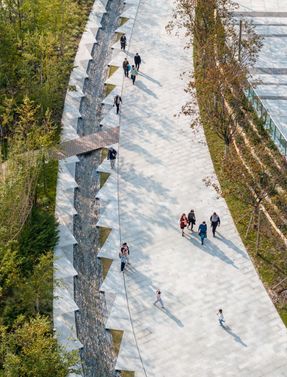Lion Mountain Park
LANDSCAPE ARCHITECT OF RECORD
Suzhou Architecture Gardens Landscape Planning Design
LEAD LANDSCAPE ARCHITECT
Tom Leader
PROJECT MANAGERS
Huan Zheng, Wei Fan
COMPETITION TEAM
Wei Chen, Pablo Alfaro, Mario Accordino, Xin Zhong, Hang Su, Yi-shan Chen, Robert Cabral, Wenmo Zhang
DETAILED DESIGN TEAM
Yang Yu, Shuping Ye, Kathryn Drinkhouse, Dawei Huang, Zhaowei Yu, Kushal Lachhwani, Si Zheng, Chen Sun, Xiaoye Xing, Wanpeng Zu, Qianyu Li, Jiawen Chen, Aiai Bao, Ying Wei, Mengyao Xing, Xiayao Shi, Chunjin Li, Ivan Valin, Thor Anderson, Scott Getz
SPONGE CITY DESIGN CONSULTANT
Jiangsu Zhuyan Design & Consulting
PAVILION DESIGN TEAM
Kuth Ranieri Architects
YEAR
2024
LOCATION
Jiangsu, China
CATEGORY
Landscape Architecture, Park
Text description provided by architect.
Dramatic Lion Mountain in Suzhou is a historical and natural feature that has forever watched over Suzhou. Prominent among local peaks, the Lion looks out to nearby Tiger Mountain and is said to defend its community!
In ancient times, poetry relating to "18 Scenes" was carved into stone along its steep trails.
Recently, its surroundings have been diminished with a run-down amusement park at its base, a small muddy lake dwarfed by roller coasters, attractions, and an aerial tram up the mountain face. Large billboards and advertisements were plastered on its face.
In 2016 TLS won an international competition to restore the greatness of Lion Mountain and create a new lake, park, and district that honors this landmark. After nine years of work, the park is complete.
Key to the transformation is the major expansion and development of the lake as a beautiful reflecting surface and ecologically diverse complement to the mountain.
Urban runoff flows through wetland terraces and cypress forests to elevate water quality suitable for human contact, hence the thriving small boat program that creates a sociable replacement for the amusement park.
A great circular promenade, two kilometers in length binds together the mountain and lake with a social and poetic program that links daily life together with 18 new narrative "scenes" on the mountain to form the natural and cultural anchor for development including a new cultural campus.
The campus program includes a Science Museum by Perkins and Will, a Civic Theater by SANAA, and a new satellite of the Suzhou Museum by GMP.
The campus has access from a new below-grade subway station - its exit opens to dramatic views of the mountain.
And visitors ascend to the promenade level through a "Canyon Garden" with spilling fountain runnels.
The forested flanks of the mountain are preserved with new ecozones established on the west side to create habitat.
Discrete mountain pathways threaded through the forest and rocky outcrops along with rustic recreation opportunities, bamboo mazes, and children's nature play fill the lower reaches.
Music composes the park's art program. A modern forest meditation by local composer, Yifang Han will fill the space of a pavilion along the promenade.
At a terraced wood deck overhanging the lake edge, one will hear a traditional/modern composition including sounds of the old amusement park.
The work is composed and performed by The Kronos Quartet in collaboration with famed Pipa player, Wu Man.

























